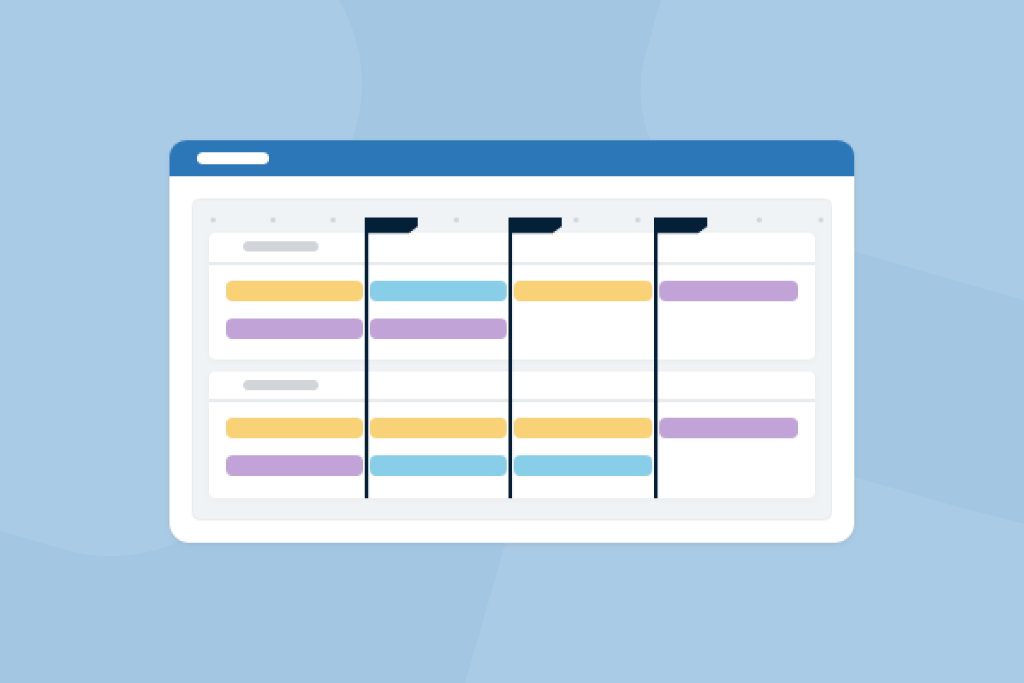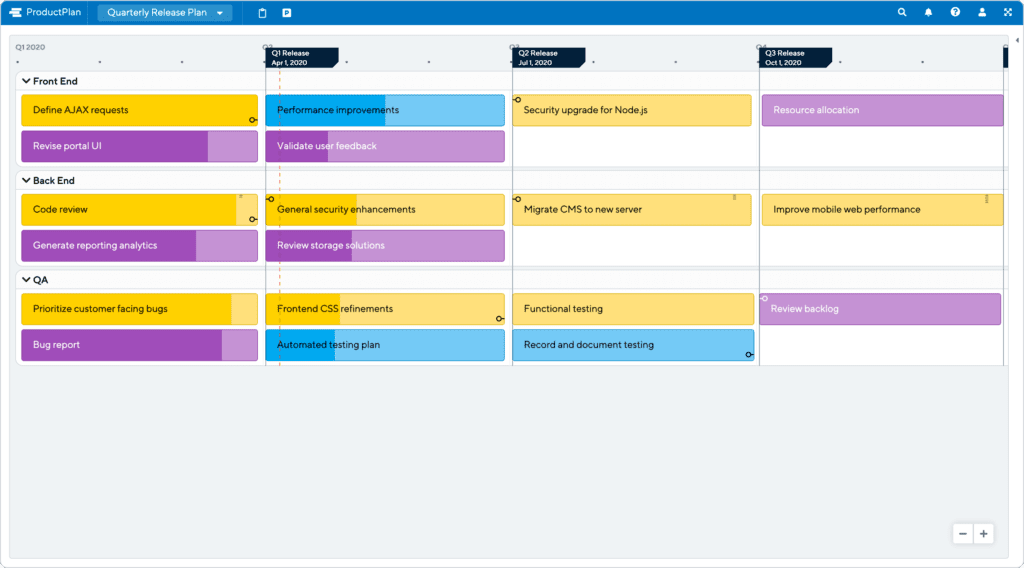What is a Quarterly Release Plan?
A quarterly release plan is a high-level visual summary of what new or updated capabilities a product will introduce to users. It is even more abstracted from details and specifics than a typical visual product roadmap as it encapsulates what’s to come in each quarter versus each particular release.
Do You Need a Quarterly Release Plan?
A quarterly release plan is best suited for occasions and audiences that don’t need—or shouldn’t see—exactly what’s happening when. It’s an opportunity to expand on the product vision, major themes, and key objectives for the product without muddying the water with too much minutia.
Quarterly release plans can be appropriate for investors and board members who care about the broad strokes and are less concerned with individual ship dates and details. They may also be appropriate for customers and prospects since it avoids too much commitment to deadlines and individual items.
Press and analysts could also be a target for quarterly release plans. They convey the intention and direction of the product strategy without raising expectations too high or giving too much to competitors.
Internally, a quarterly release plan can be an informative and inspirational artifact for a broad audience, such as at a company all-hands meeting. Some internal teams, such as product development, require more nitty-gritty details. On the other hand, it could be an adequate level of granularity for sales, marketing, and operational functions.
The Benefits of a Quarterly Release Plan?
Quarterly release plans hit the sweet spot between vague vision statements and super-specific project plans. They illustrate the direction of the product, how it will get there, and what stakeholders can expect.
Simultaneously, they prevent strategic discussions from getting sidetracked into debates regarding specific features or arbitrary release dates. While there may still be questions regarding the prioritization of initiatives and the corresponding rationale, conversations are less likely to turn into fierce debates, given the details’ intentional vagueness.
Quarterly release plans are excellent for illustrating the power of themes. Without unnecessary implementation details or specific features, the audience can focus on the major steps to execute the strategy.
It elevates the importance of KPIs, outcomes, and North Star metrics, showing how those principles are guiding the plans for the product and not simply checking boxes by adding a particular feature or enhancement. This broader context is essential in getting some resistant stakeholders over the hump of accepting the fluidity required to embrace experimentation, responsiveness, and an Agile approach to delivery.
Create a Quarterly Release Plan
Here’s a five-step plan for building a quarterly release plan.
Step 1: Identify your strategic objectives
Before going too far, it’s essential to understand what you’re trying to accomplish. Most likely, it’s not only to provide some insight to stakeholders into what you’re building but also what strategic objectives you’re meeting via these quarterly releases.
Step 2: Know your audience(s)
Who is looking at your quarterly release plan is almost as important as what is in it. Different cohorts care about different things, plus you may want to hold your cards a little closer to your chest if customers or other external parties are seeing this.
Executives are looking for high-level, big-impact items. Sales and marketing want to know which capabilities they can tout to prospects. Product development, UX, operations, and support need more detail and specifics around dates and deadlines.
By building the quarterly release plan with a purpose-built planning tool with a web viewer, you’ll meet all of these requirements with a single plan with customized views for those various crowds. It will keep all the info in sync and minimizes maintenance overhead compared to attempting to manage multiple artifacts.
Step 3: Establish the themes
Grouping individual features and functionality under an umbrella of themes is a wise approach, especially the further into the future those quarters extend. Showing the audience what major initiatives are in the works, the focus shifts to impacts and outcomes rather than nitpicking over details.
Staying high level keeps everyone operating at a strategic level. Then, you can operate with more granular clarity when the actual release dates are closer.
Step 4: Determine your timeline
Deciding how far into the distance, your plan will range has major implications. If it’s too short, stakeholders may think the strategy isn’t complete. Too long and you risk overcommitting and setting false expectations.
Finding the sweet spot is part of the challenge of dealing with both short-term priorities and long-term goals. Usually, 12-18 months tend to be the upper bounds of most product teams’ comfort zones.
Step 5: Plot out your plan
With the playing field set, it’s time to map out the attack. Here is when you slot in which themes to tackle and when keeping in mind any resource and bandwidth constraints and allowing adequate time for A/B tests and iterative development based on customer feedback.
Tips for Sharing Your Quarterly Release Plan
After all that hard work, it’s tempting to fire it off to the entire company and bask in their praises. But how you present a quarterly release plan is as key as its contents.
Just as important as understanding the varying levels of information for each audience, knowing the interests and motivations of whom you’re presenting it to is equally vital.
Try anticipating their concerns and likely questions, and be ready with well-considered answers. If something will be controversial or disappointing, prepare for those complaints with a carefully worded response.
Set the stage for success by first covering the company and product goals and objectives. This way, you can position the plan as a method for achieving those. People should walk away, agreeing that the team’s choices are intending to make the most positive impact on KPIs as possible.
It’s also important to remind everyone that this plan will change. Give them an idea of how often they should expect to receive updates and then follow through by delivering those. Even without a full meeting, deliver a brief explanation of what’s changed along with significant revisions.
Aim High, Stay High
Quarterly release plans are by design more high-level roadmaps. Don’t fall into the trap of trying to cram too many details into it. It diminishes its value and draws the audience’s focus in rather than showing them the big picture.
Rely on project management tools for tracking more granular elements. It keeps the quarterly release plan clean and focused on the major themes, KPIs, and objectives that matter.
Searching for more roadmap inspiration? Look at our templates.





